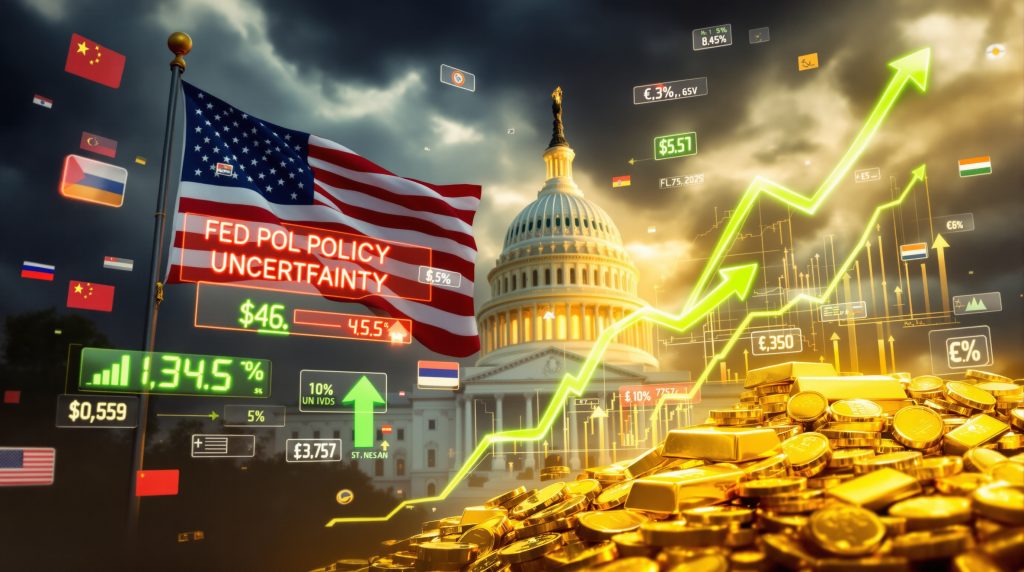Government Shutdown Resolution Creates Complex Gold Market Dynamics
The conclusion of government shutdowns creates a unique economic environment that consistently influences precious metals markets through interconnected pathways that extend far beyond simple political resolution. When federal agencies resume operations after extended closures, the resulting market dynamics often surprise investors who expect immediate normalization of trading patterns.
Understanding these mechanisms helps investors anticipate price movements and position portfolios strategically during periods when institutional uncertainty transforms into monetary policy uncertainty. The end of government shutdown impacts on gold prices involves multiple layers of economic data interpretation, Federal Reserve policy recalibration, and market psychology that can persist for months after political agreements are reached.
Economic Data Disruption and Fed Policy Uncertainty
When federal agencies cease operations during shutdowns, critical economic reporting comes to a complete halt. The Bureau of Labor Statistics, Commerce Department, and Treasury stop publishing employment figures, inflation data, and GDP updates that typically guide Federal Reserve decision-making processes. This information vacuum forces central bank officials to operate with severely compromised visibility into actual economic conditions.
During the October 2025 government shutdown that lasted 41 days, key datasets including the October employment report and specific inflation metrics became permanently compromised or entirely lost. Survey response rates dropped dramatically during the closure period, making subsequent data releases unreliable for policy-making purposes.
The Federal Reserve's heavy reliance on timely economic indicators means any significant disruption creates cascading policy uncertainty. Markets consistently interpret this uncertainty as increasing the likelihood of accommodative monetary policy, as central bankers typically err on the side of caution when operating with incomplete economic intelligence.
Critical factors driving Fed uncertainty during shutdown recovery:
- Survey methodology disruptions affecting data quality for months after reopening
- Permanent loss of time-sensitive economic indicators from shutdown periods
- Reduced Federal Reserve official communications to avoid political appearance
- Delayed publication schedules creating gaps in policy-making timelines
- Compromised baseline data affecting future economic comparisons
Lower interest rate expectations emerging from this uncertainty reduce the opportunity cost of holding non-yielding assets like gold, driving increased institutional and retail demand that can persist well beyond political resolution.
Dollar Weakness and Safe-Haven Flow Mechanics
Political dysfunction leading to extended government shutdowns typically weakens the U.S. dollar as international investors begin questioning the fundamental stability of American governmental institutions. This currency weakness makes gold more attractive to foreign buyers while simultaneously reducing the relative cost of precious metals denominated in other currencies.
The November 2025 gold market surge to $4,207 per ounce following shutdown resolution demonstrated this dynamic clearly. Rather than declining after political agreement, gold achieved five consecutive sessions of gains reaching three-week highs as markets began pricing in potential Federal Reserve policy accommodation based on compromised economic data availability.
Multi-layered safe-haven demand drivers include:
- Institutional memory of recurring political dysfunction creating baseline uncertainty premiums
- International reserve diversification away from dollar-dependent assets
- Central bank accumulation strategies accelerating during periods of U.S. institutional stress
- Currency debasement concerns highlighted by events like discontinuation of penny production
- Professional investor positioning for extended monetary policy accommodation cycles
The dollar's softening during shutdown recovery periods reflects trader expectations of higher Federal Reserve easing probabilities rather than celebration of political resolution. Furthermore, this creates sustained precious metals demand that often surprises observers expecting immediate price normalization.
Duration-Based Price Impact Analysis and Recovery Patterns
Historical analysis reveals that gold's response to government shutdowns follows predictable patterns based on duration, economic context, and the quality of data compromise during closure periods. The end of government shutdown impacts on gold prices varies significantly depending on how long institutional disruption persists and which specific economic datasets become compromised.
Shutdown Duration and Market Response Framework
| Shutdown Length | Typical Gold Response | Recovery Timeline | Data Impact Level |
|---|---|---|---|
| 1-3 days | 0.5-1.2% price increase | 1-2 weeks | Minimal data loss |
| 1-2 weeks | 1.5-3.0% price increase | 3-4 weeks | Survey disruption |
| 3+ weeks | 3.0-8.0% price increase | 6-12 weeks | Permanent data loss |
| 35+ days | 5.0-12.0% price increase | 12-24 weeks | Methodological compromise |
The October 2025 shutdown lasting 41 days represents the longest government closure in recent history, exceeding even the December 2018-January 2019 shutdown that previously held duration records. Extended shutdowns create more significant and lasting effects because they generate genuine economic disruption beyond mere political theater.
Key factors determining recovery timeline complexity:
- Quality degradation of subsequently released economic data
- Federal Reserve policy recalibration requirements based on compromised information
- Market institutional memory creating faster reaction times to future shutdown threats
- Central bank purchasing pattern changes during uncertainty periods
- Retail investor behaviour shifts toward tangible asset accumulation
Each shutdown creates precedent for future political standoffs, contributing to baseline uncertainty levels that support precious metals demand even after immediate crises resolve. In addition, markets develop institutional memory of these events, leading to increasingly pronounced reactions to shutdown threats over time.
Data Quality Degradation Effects
Even when government operations resume, the quality and reliability of subsequently released economic information often remains compromised for extended periods. Survey response rates that declined during closures don't immediately recover, and data collection methodologies may require months to return to pre-shutdown reliability standards.
The Bureau of Labor Statistics specifically warned that survey response rates dropped sharply during the October 2025 shutdown, making certain datasets unreliable for Federal Reserve policy-making purposes. This degradation can persist for 6-12 months following shutdown resolution, creating extended periods of policy uncertainty that continue supporting precious metals prices.
Specific data quality issues emerging post-shutdown:
- Reduced survey participation rates affecting employment statistics accuracy
- Compromised seasonal adjustment factors due to missing baseline data
- Delayed economic indicator publications disrupting Fed decision-making schedules
- International economic coordination difficulties due to data gaps
- Baseline comparison problems for future economic performance measurements
Central Bank Strategic Reserve Diversification During Political Uncertainty
Central banks accelerate gold accumulation during periods of U.S. political instability as components of broader reserve diversification strategies designed to reduce dependence on dollar-dominated assets. These institutional decisions view American political dysfunction as validation signals for increasing holdings of politically neutral stores of value.
Emerging Market Central Bank Acceleration Patterns
During and immediately following the October 2025 shutdown, three central banks—Russia, India, and Saudi Arabia—quietly began buying silver, signalling the return of precious metals as legitimate monetary assets rather than purely industrial commodities. This represents a significant shift in central bank reserve management strategies that extends beyond traditional gold accumulation.
Central bank precious metals accumulation strategies:
- Russia: Accelerated covert gold accumulation programmes despite international sanctions
- India: Strategic silver purchasing programmes alongside continued gold reserve building
- Saudi Arabia: Diversification initiatives away from pure dollar-denominated reserves
- China: Continued expansion of undisclosed precious metals holdings through various channels
The timing of these purchases creates additional upward pressure on precious metals prices during and immediately following shutdowns. For instance, central bank buying typically occurs in large institutional blocks that can move markets significantly, especially when combined with retail investor demand spikes driven by political uncertainty.
Strategic timing advantages for central bank accumulation:
- Political uncertainty creating temporary price depression opportunities
- Reduced market liquidity during shutdown periods enabling larger position building
- Dollar weakness periods providing favourable exchange rate conditions
- Institutional distraction creating less competitive bidding environments
- Long-term strategic positioning independent of short-term political resolution
Emerging market central banks particularly view frequent U.S. shutdowns as evidence supporting systematic de-dollarisation strategies, using these events as opportunities to accelerate precious metals accumulation at relatively attractive pricing levels.
Economic Data Gaps and Gold Price Sensitivity Hierarchy
Not all delayed economic reports carry equal weight in driving precious metals prices during shutdown recovery periods. Understanding which data releases create maximum market impact helps investors anticipate price movements and position portfolios strategically during information vacuum periods.
Critical Data Release Impact Framework
Tier 1 Impact – Highest Gold Price Sensitivity:
- Monthly Employment Situation Report: Primary Fed policy input for labour market assessment
- Consumer Price Index (CPI): Core inflation measurement driving interest rate expectations
- Producer Price Index (PPI): Upstream inflation pressure indicators
- GDP Preliminary Estimates: Comprehensive economic performance measurements
Tier 2 Impact – Moderate Gold Price Sensitivity:
- Retail Sales Data: Consumer spending pattern indicators
- Industrial Production Figures: Manufacturing sector performance metrics
- Housing Market Indicators: Real estate sector stability measurements
- Trade Balance Reports: International economic relationship assessments
The October 2025 shutdown specifically compromised the October employment report and certain inflation metrics, representing direct impacts to Tier 1 data categories that create maximum Federal Reserve policy uncertainty. When these specific datasets become unavailable or unreliable, markets consistently position for potential monetary policy accommodation.
Federal Reserve dependency hierarchy explains gold sensitivity:
- Employment metrics receive dual mandate priority in Fed decision-making processes
- Inflation measurements directly influence price stability mandate interpretations
- GDP data provides comprehensive economic health assessments for policy calibration
- Secondary indicators support but don't drive primary policy determinations
Survey methodology disruptions during shutdowns create cascading reliability issues affecting not only immediate data releases but also future economic comparisons requiring baseline references from compromised periods.
Interest Rate Expectations and Fed Communication Disruption
Government shutdowns systematically alter market expectations for Federal Reserve policy through multiple channels that extend well beyond simple data availability issues. The combination of delayed economic indicators, political risk premiums, and reduced central bank communications creates conditions that typically favour more accommodative monetary policy expectations.
Fed Communication Strategy During Political Uncertainty
During shutdown periods, Federal Reserve officials consistently reduce public communications to avoid appearing to take political positions on governmental dysfunction. This communication reduction forces markets to interpret policy intentions with limited official guidance, typically resulting in dovish bias as investors position defensively for potential economic disruption.
Communication gap impacts on market expectations:
- Reduced Fed official speaking engagements creating information asymmetry
- Limited forward guidance availability increasing policy uncertainty premiums
- Market reliance on historical precedent rather than current Fed thinking
- Professional investor positioning for worst-case policy scenarios
- International central bank coordination difficulties due to communication limitations
Interest rate futures markets consistently price in higher probabilities of rate cuts during extended shutdowns, even when underlying economic conditions might not otherwise warrant monetary policy easing. However, the dollar's softening during the November 2025 shutdown recovery reflected traders pricing in higher Federal Reserve easing probabilities later in the year.
Policy Uncertainty Premium Mechanisms
The end of government shutdown impacts on gold prices often involves policy uncertainty premiums that persist well beyond political resolution. Markets develop baseline expectations of potential future disruptions that support precious metals demand even during periods of apparent institutional stability.
Fed leadership transition impacts during political uncertainty:
- Atlanta Fed President Raphael Bostic announced retirement effective February 28, creating policy committee vacancy
- Trump administration indirect influence over regional Fed bank appointments through Board of Governors approval process
- Potential dovish shift in Fed leadership accelerating rate cut timelines
- Regional Fed bank independence concerns during politically sensitive periods
Leadership transitions occurring during shutdown periods create additional layers of policy uncertainty that markets interpret as potentially supporting more accommodative monetary policy approaches over extended timeframes.
Gold Investment Vehicle Performance During Shutdown Periods
Different gold investment alternatives respond variably to shutdown-driven market conditions, with physical precious metals typically outperforming paper alternatives during periods of institutional uncertainty. Understanding these performance differentials helps investors optimise portfolio positioning during political dysfunction events.
Physical Gold Versus Paper Gold Performance Analysis
Physical Gold (Coins, Bars, Allocated Storage):
- Strongest performance during extended shutdown periods due to tangible asset demand
- Storage and delivery premiums increase during uncertainty periods
- Retail investor demand spikes creating supply constraints in physical markets
- Limited immediate supply availability can amplify price movements significantly
- Independent of counterparty risks during institutional uncertainty periods
Gold ETFs and Mining Stock Performance:
- More volatile than physical gold due to equity market correlation effects
- Subject to broader stock market movements that may contradict gold fundamentals
- Can underperform physical gold if general equity markets decline during shutdowns
- Higher liquidity advantages but increased correlation risks during market stress
- Management fee impacts during extended uncertainty periods
Professional Trading Vehicles (Futures, Options):
- Significant volatility amplification through leverage mechanisms
- Professional trader focus rather than strategic investment positioning
- Active management requirements during rapidly changing political conditions
- Margin call risks during extreme price movements
- Short-term speculation tools rather than wealth preservation strategies
The October 2025 shutdown demonstrated these performance differentials clearly, with physical gold achieving sustained gains while some mining stocks experienced volatility due to broader market uncertainty about economic impacts.
Long-Term Implications for Gold Pricing and Monetary Systems
Recurring government shutdowns create structural changes in how international markets perceive U.S. political and economic stability over extended timeframes. Each shutdown episode contributes to gradual erosion of confidence in American institutional reliability, supporting secular trends toward alternative stores of value that extend far beyond individual political events.
Institutional Confidence Erosion and Global Reserve Implications
International investors increasingly view frequent shutdowns as evidence of systemic dysfunction in American governance structures. This perception supports long-term diversification strategies moving away from dollar-denominated assets and toward precious metals, creating sustained demand pressure that provides floor-level pricing support.
Cumulative effects of recurring shutdown events:
- Baseline political risk premiums embedded in precious metals pricing structures
- International reserve diversification acceleration among emerging market economies
- Dollar-based trade system questioning leading to alternative arrangement exploration
- Precious metals monetary function revival as politically neutral reserve assets
- Institutional memory formation creating faster market reactions to future political dysfunction
The October 2025 shutdown lasting 41 days represents the longest government closure in American history, creating precedent for institutional dysfunction that international partners interpret as systemic rather than episodic political disagreement.
Global Reserve Currency System Evolution
Repeated shutdowns accelerate international discussions among trading partners about practical alternatives to dollar-based trade and reserve systems. While these transitions occur gradually over decades rather than years, they represent fundamental structural shifts supporting long-term precious metals demand as countries seek politically neutral reserve assets.
Structural monetary system changes emerging:
- Central bank precious metals accumulation programmes expanding beyond traditional gold reserves
- Bilateral trade agreements reducing dollar dependency in international commerce
- Regional currency arrangements developing among geographically proximate economies
- Digital currency experimentation by central banks seeking dollar alternatives
- Commodity-backed monetary systems gaining theoretical and practical consideration
The end of government shutdown impacts on gold prices extends far beyond immediate political resolution because these events contribute to longer-term questioning of dollar-based monetary system stability and reliability. Furthermore, understanding the gold market relationship with broader economic cycles helps investors position themselves strategically during these periods of uncertainty.
Consequently, investors seeking to capitalise on these dynamics often consider gold strategic investment approaches that account for both short-term shutdown effects and longer-term monetary system evolution. The gold price forecast remains optimistic given these structural changes, particularly as markets price in the sustained effects of political dysfunction.
Investment Perspective: Government shutdown resolutions create predictable patterns of gold price appreciation through Federal Reserve policy uncertainty, dollar weakness, and sustained safe-haven demand. Understanding these dynamics helps investors position portfolios to benefit from political dysfunction while managing associated risks through diversified precious metals exposure strategies.
Currency Debasement Acceleration Indicators:
The U.S. Mint's final penny production on November 13, 2025, after 238 years of circulation represents tangible evidence of currency debasement effects. Production costs reaching four cents per coin—nearly four times face value—demonstrate how inflation renders traditional monetary denominations economically obsolete.
This development provides concrete validation for precious metals investors who view physical gold and silver as protection against systematic currency debasement that government shutdowns both reflect and potentially accelerate through compromised fiscal discipline and monetary policy uncertainty. The continuing surge of record-high gold prices reflects these underlying concerns about monetary stability.
The $56 million annual savings from discontinuing penny production, while fiscally responsible, symbolises broader institutional recognition that traditional monetary systems face fundamental structural challenges requiring alternative store-of-value solutions for wealth preservation strategies. Additionally, Reuters reports that gold continues to extend its gains even after political agreements are reached, highlighting the persistent nature of these market dynamics.
For investors seeking expert analysis on navigating these complex market conditions, Kitco provides comprehensive coverage of how debt concerns continue influencing gold prices even after shutdown drama subsides, reinforcing the long-term implications of political dysfunction on precious metals markets.
Looking to Navigate ASX Mining Opportunities During Market Uncertainty?
Discovery Alert instantly identifies significant ASX mineral discoveries using its proprietary Discovery IQ model, providing real-time alerts when market volatility creates compelling investment opportunities. Explore why major mineral discoveries can generate exceptional returns and begin your 30-day free trial today to position yourself ahead of the market during these periods of uncertainty.




